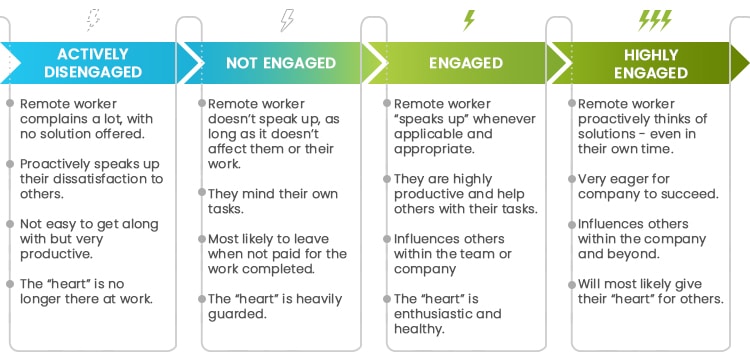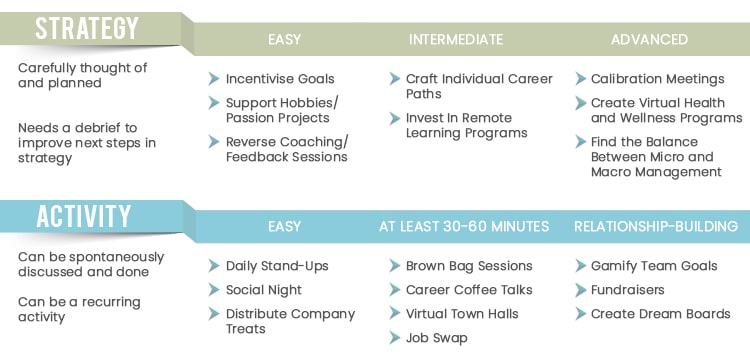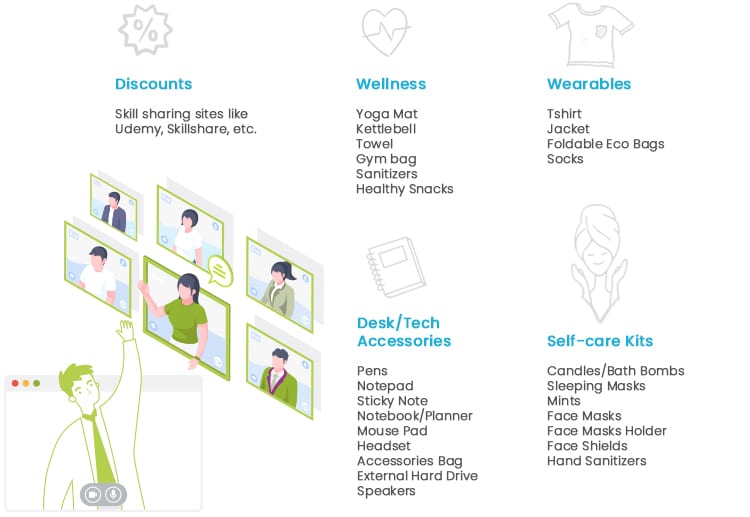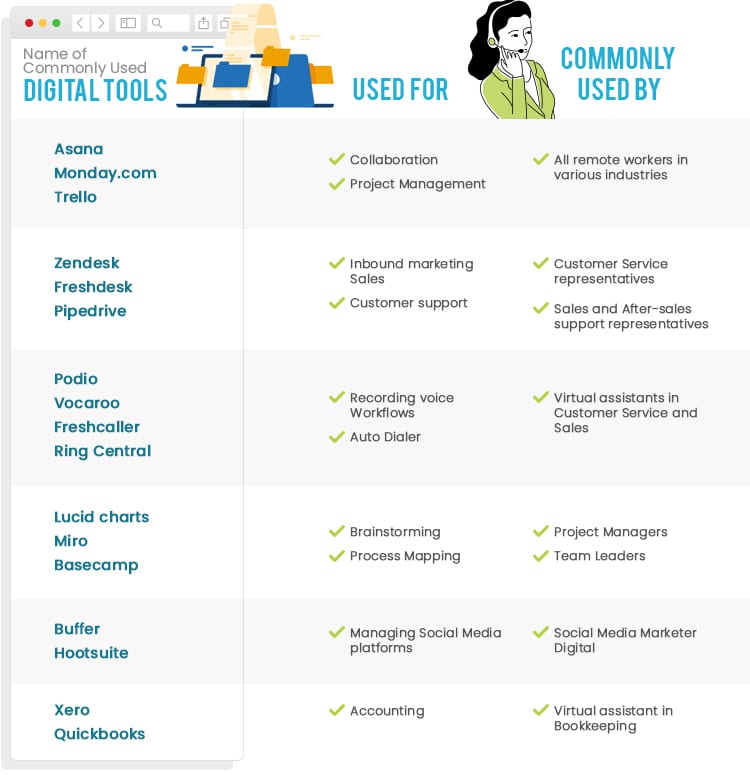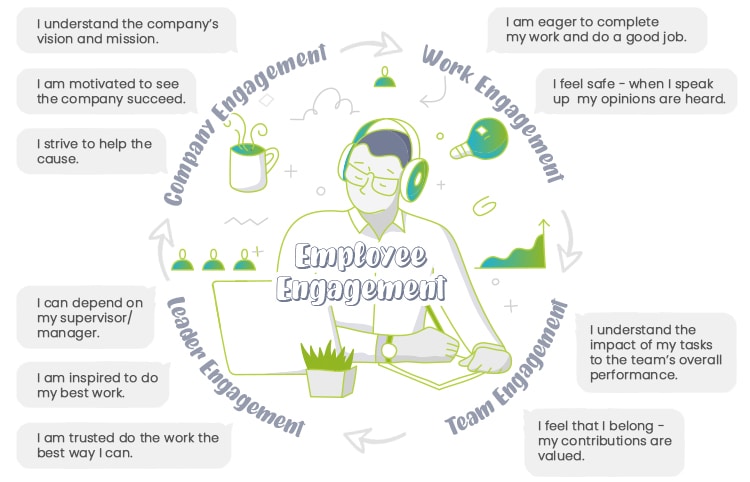Do efforts in employee engagement stand in the way of being a profitable business?
The answer is – No.
In the 2016 and 2020 Gallup Meta-analysis Reports on the Relationship Between Engagement at Work and Organizational Outcomes, they found that employee engagement is linked to loyalty, increased sales, and improved productivity.
It’s common to assume that when remote workers are productive – that is when they complete the tasks they’re assigned or asked to do – it means that they are “engaged”.
This is not always the case.
Why is engagement more difficult for remote employees?
Remote employee engagement is the measure of how committed remote workers are to their work, team, leaders, and organization – mentally and emotionally. Each person has their reasons for working in a particular role and organization.
Leaders and organizations need to move their employees’ power sources for doing more in line with the company’s success instead of just their benefit to increase employee engagement. As a result, some companies put much emphasis on monitoring employees’ tasks and absenteeism.
The real focus of remote employee engagement is to make sure that each remote worker understands that their accomplishments – both monitored and not monitored – contribute to the success or failure of their company’s vision and mission.
How do I know if my employees are truly “engaged”?
Everybody wants to do “meaningful work”. No one got up, dressed up, and started preparing for work thinking that they would not accomplish anything worthwhile.
The key points to employee engagement success are having clear and measurable goals and open and honest communication.
Clear and measurable goals raise employee contributions. Employees want to do a good job but to be engaged, we all want to know if what we’re doing has a purpose. And this purpose should be communicated and translated into realistic goals each employee could achieve at a time.
On the other hand, open and honest communication helps remote employees be informed and gives them visibility on their progress and challenges.
Remote Employee Engagement Ideas to Try
Employee engagement is driven by the following factors:
-
- Motivation or drive to succeed in completing the tasks
- Safety and sense of belongingness within the team
- Value to the leader
- Contribution to the organization
To improve employee engagement in your remote workforce, there are strategies and activities you can try. The differences between the two are outlined below:
Although the goal is a long-term engagement, both strategic and tactical approaches should be planned and adjusted to the remote workers’ needs.
Strategies would take most of the time preparing. While activity suggestions stated here are more tactical in approach, they still shouldn’t be executed without a plan.
Remote employee engagement is more challenging because there are fewer seen non-verbal cues. How can you truly connect “heart-to-heart” despite the distance?
Here are the strategies and activities grouped by the factors that drive employee engagement:
Work Engagement
#1. Find the Right Balance Between Micromanagement and Macro management
Being far away from each other doesn’t mean either one of the managing styles above is going to increase job performance and engagement. When managing remote Filipino workers, giving autonomy at work, while respecting the agreed working schedule is one way of building trust.
#2. Encourage Them to Create Dream Boards for Important Goals
Using printouts or cutouts from old magazines or books, creating dream boards can help your remote workers visualise and express their personal goals. Remember, to engage remote workers is to align their goals to the company’s mission.
To help your remote workers map theirs is the first step to understanding them better and connecting it to your vision.
#3. Support Their Hobbies and Passion Projects
Whether it’s planting indoor plants or learning to play an instrument, find a way to either fund or give them more breaks to do these types of activities. As a sign of support, you can also let them “showcase” their work of art in one of your team meetings.
#4. Incentivise Goals
Perhaps your remote employee has been achieving weekly goals like they can do their work in their sleep. It’s time to put incentives like more personal time, recognition, money, or promotion as a reward for their hard work.
#5. Conduct Daily Stand-Ups
Make them accountable for their work by asking them how their day went. It can be a very informal way of outlining what they have accomplished, what their challenges were, and how they want to start the next day. When one remote worker cannot join, you can ask them to record it and send it to the rest of the team.
#6. Manager for a Day
If you haven’t tried giving autonomy to your team members, go cold turkey with letting them take the lead in a meeting. Take notes of what went well and what could improve. Don’t be surprised if they impersonate you at first – the most memorable meetings usually are the ones that inject a little humour.
Team Engagement
#7. Plan and Schedule Brown Bag Sessions
Brown bag sessions are usually conducted where one member of the team talks about the steps they did in completing a task or project while the rest of the team drank coffee or ate lunch. In a remote working environment, not only is this a way for effectively sharing best practices, but it also is a fun idea to try especially when there is a budget to spend for a little snack.
#8. Calibration Meetings
Since the purpose of conducting these is to adjust your knowledge to do tasks the right way, there’s a tendency for people to talk over each other in virtual calibrations. Everyone can use a cut-out of different emojis to participate and convey their thoughts and emotions.
You can also send the agenda in advance to keep the meeting within the timeframe agreed.
#9. Gamify Team Goals
Games are used as ice breakers during meetings and training. They can also be used as a method in cultivating healthy competition in the team. When facilitated correctly, you will uncover some of their strengths and weaknesses.
Some ideas you can try are online multiplayer games that include strategic thinking and deduction like Among Us or Mobile Legends, timed trivia, or stream a murder mystery. The winner gives some of their tasks to the losers.
#10. Social Night
Dedicate a day in a week when the whole team can just have a virtual “wine and dine” night while watching a movie or chatting about non-work-related stuff.
You can also play games like “Never Have I Ever”, “Heads Up!” or do a Karaoke jam night.
#11. Do Fundraisers Together
You and your remote workers can use your talents and skills outside of work to raise funds for a charity of your choice. You can try live band streaming, online selling, or simply donate part of your team funds or own money.
Leader Engagement
#12. Job Swap
For remote workers who you think are ready to take on more responsibilities, try swapping one or two tasks for a day or week. In this activity, you give your remote workers a glimpse of some leadership skills they need to learn. Just be sure to conduct a feedback session after to review afterward.
#13. Career Coffee Talks
Unlike Brown Bag sessions, career coffee talks are informal sessions that leaders can do to tell them the story of how they started in the industry and what they managed to do when they failed.
Like, who wouldn’t want to know how to climb up the ladder of success, right? I do!
#14. Reverse Coaching/Feedback
A leader who coaches a subordinate will naturally lean on an authoritative style. Whereas coaching in general, what we aim to do is ask questions so the remote worker is aware of their own behaviors that affect their performance.
In reverse coaching, instead of asking them, let the remote workers walk you through their thoughts while they were performing a particular task. Let them share and ask the questions and you’ll uncover their style and behaviours that you can’t observe in a remote work set-up.
#15. Outline Mentorship Programs
Mentorship doesn’t have to be all about the work that you do. Having a mentor who has the same interest or background as you can help boost morale for daily struggles. Mentorship does not only cover challenges at work but also in life.
#16. Craft Individual Career Paths
First, get your remote worker’s perspective on their career progression. Next, ask your team member to outline the steps and tools they think is needed to get to where they want to be. Then, make your remote worker understand that they are not alone in their career development.
Finally, commit to an understanding that you’d do the best you can to expose them to different roles, immerse them in what others do best, and expand their knowledge.
Company Engagement
#17. Conduct Virtual Town Halls
Instead of conducting surveys, one approach to give and receive feedback is to just “sit down” and ask them, “Do these policies help you or hinder you?” “What do you think of the plans for executing this project? Are there any pitfalls you see?” “What can we do as an organization to further the cause/mission?”
A direct line of communication to key decision-makers in the company makes remote employees feel heard and valued. A virtual town hall doesn’t need to be too long or formal – it just needs to be sincere.
#18. Distribute Customized Company Treats
Company goodies add pride to the remote employees using or wearing them. Customized items as simple as canisters, notebooks, and pens to wearables like caps, blankets, T-shirts, or gym bags can remind them that despite the distance, we still work as a team.
#19. Create Virtual Health and Wellness Programs
Keeping a healthy and focused mindset is challenging especially when working remotely. So to have access to experts talking about how to combat burnout, loneliness, and isolation is truly a gem and a plus if it comes from the organization employees work so hard for. You can organize recorded yoga or Zumba classes so remote workers can asynchronously join without paying for a separate subscription. There are classes also for meal planning and gardening.
Other fun and engaging ideas to include are financial wellness talks like investing, savings, and spending.
#20. Invest In Remote Workforce Learning Programs
According to CNBC, they said that LinkedIn’s Workforce Learning Report in 2019 mentioned that younger employees stay in a company that offers learning programs.
Whether you choose to support a short course or a full training program, make sure to get feedback from your remote worker. During those feedback sessions, you both learn more about each other and the gap in knowledge and skills in your company.
#21. Plan Good Retirement and Savings Opportunities
Create a plan for their savings and retirement. It boosts morale because it shows that you’re investing in your employees long-term and that you care for their future as well.
Filipino remote workers will highly appreciate such opportunities for them to save for their retirement as such sometimes is last in their priority to support their families.
#22. Embed Employee Rewards in Initiatives
Recognition is one of the basic needs of a remote worker. With limited visuals and the challenges of connecting online, these simple suggestions below are now considered big gestures:
- Write a “Thank You” or email or instant message
- Give lunch money to anyone who refers quality candidates (like an Employee Referral Program) and or additional clients for you
- Award a certificate for monthly or quarterly goals they meet or exceed and many more.
#23. Invest in Technology and Devices
To improve the way remote teams work together, invest in your work tools. Gather end users of each tool, sit down with them, and get feedback on how each tool’s features and benefits help them complete tasks more efficiently.
It will take well-thought-out, fun, and sincere activities to uncover what your remote workers truly feel about how you execute your vision, day in and day out.
You’d be surprised how impactful a simple conversation with your remote worker can do. There are no band-aid solutions to increase employee engagement.
It takes hard work and a heart of service – not just to hire the right people for you – but also to retain and engage them.



